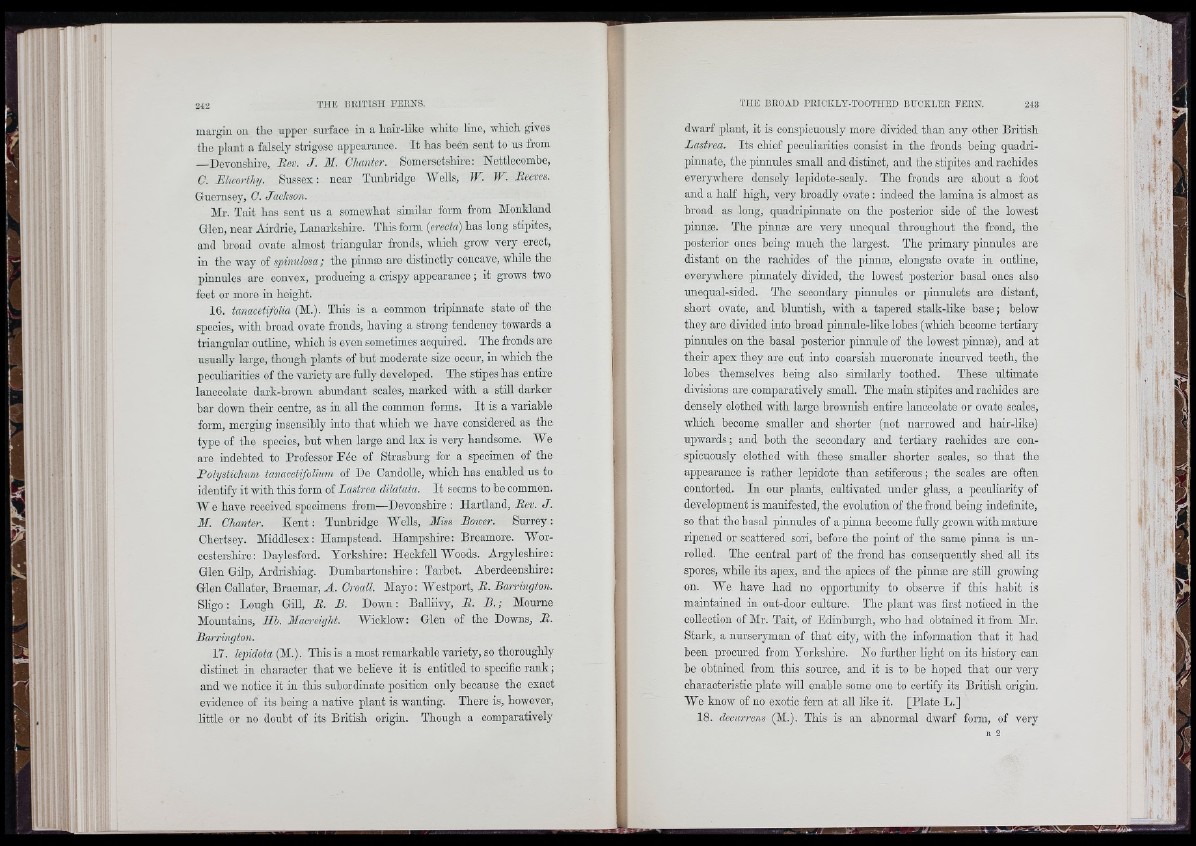
margin on the upper surface in a hair-like white line, which gives
the plant a falsely strigosc appearance. I t has been sent to us from
—Devonshire, liev. J . 31. Chciutey. Somersetshire: Nettleoomhe,
C. Ehcorthy. Sussex: noar Tunhridgo Wells, W. W. lieeves.
Guernsey, C. Jachson.
Mr. Tait has sent us a somewhat similar form from Monkland
Glen, near Airdrie, Lanarkshire. This form [erecta) has long stipites,
and broad ovate almost triangular fronds, which grow very erect,
in the way of spinulosa; tho pinnæ are distinctly concave, while the
pinnules are convex, producing a crispy appearance ; it grows two
feet or moro in height.
16. tanacetifolia (M.). This is a common tripinnate state of tho
species, with broad ovato fronds, having a strong tendency towards a
triangular outhne, which is even sometimes acquired. The fronds aro
usually large, though plants of hut moderate size occur, in which the
peculiarities of the variety are fully developed. The stipes has entire
lanceolate dark-hrown abundant scales, marked with a still darker
bar down their centre, as in all the common forms. I t is a variable
form, merging insensibly into that which wo have considered as the
type of the species, hut when large and lax is very handsome. We
are indebted to Professor Fée of Strashnrg for a specimen of the
Polysticlmm tanacetifolimn of De Candolle, which has enabled us to
identify it with this form of Lastrea dilatata. I t seems to he common.
W e have received specimens from—Devonshire : Hartland, Eev. J .
31. Chanter. K en t: Tunbridge Wells, 3Iiss Bower. Surrey:
Chertsoy. Middlesex: Hampstead. Hampshire; Broamore. Wor-
cestershii-e: Daylesford. Yorkshire: Heckfell Woods. Argyleshii’e :
Glen Gilp, Ardrishiag. Dumbartonshire : Tarhet. Aberdeenshire:
Glen Callater, Braemar, A . Croall. Mayo: Westport, R . Barrington.
Shgo : Lough GiU, R . B. Down : Balliivy, R . B. ; Mourne
Mountains, Hb. 31acreight. Wicklow: Glen of the Downs, R.
Barrington.
17. lepidota (M.). This is a most remarkable variety, so thoroughly
distinct in character that wc heheve it is entitled to specific rank ;
and wc notice it in this subordinate position only because the exact
evidence of its being a native plant is wanting. There is, however,
httle or no doubt of its British origin. Though a comparatively
dwarf plant, it is conspicuously moro divided than any other British
Lastrea. Its chief peculiarities consist in the fronds hoing quadripinnate,
the pinnules small and distmct, and the stipites and raohides
everywhere densely lopidoto-soaly. The fronds are about a foot
and a half high, very broadly ovate : indeed the lamina is almost as
broad as long, quadripinnato on the posterior side of the lowest
pinnm. Tho pinnæ aro very unequal throughout the frond, the
posterior ones bemg much the largest. The primary pinnules are
distant on the raohides of the pinnæ, elongate ovate in outhne,
everywhere pinnately divided, the lowest posterior basal ones also
unequal-sided. The secondary pinnules or pinnulets are distant,
short ovate, and bluntish, with a tapered staUi-hke base ; below
they aro divided into broad pinnule-hke lobes (which become tertiary
pinnules on the basal posterior pinnule of the lowest pinnæ), and at
their apex they are out into coarsish muoronate incurved teeth, the
lobes themselves being also similarly toothed. These ultimate
divisions are comparatively smaU. The main stipites and raohides are
densely clothed with largo brownish entire lanceolate or ovate scales,
which become smaller and shorter (not narrowed and hair-like)
upwards ; and both the secondary and tertiary raohides are conspicuously
clothed with these smaller shorter scales, so th a t tho
appearance is rather lepidote than setiferous ; the scales are often
contorted. In onr plants, cultivated under glass, a peculiarity of
development is manifested, the evolution of the frond boing indefinite,
so th a t tho basal pinnules of a pinna become fuUy grown with mature
ripened or scattered sori, before the point of the same pinna is unrolled.
The central part of the frond has consequently shed aU its
spores, while its apex, and the apices of the pinnæ are still growing
on. We have had no opportunity to observe if this hahit is
maintained in out-door culture. The plant was first noticed in tho
coUection of Mr. Tait, of Edinburgh, who had obtained it from Mr.
Stark, a nurseryman of th a t city, with tho information that it had
been procured from Yorkshire. No further light on its history can
be obtained from this source, and it is to be hoped th a t our very
charactoristio plate will enable some one to certify its British origin.
We know of no exotic fern at aU hke it. [Plate L.]
18. deeurrens (M.). This is an abnormal dwarf form, of very
E 2
H ■ , ll
.1'